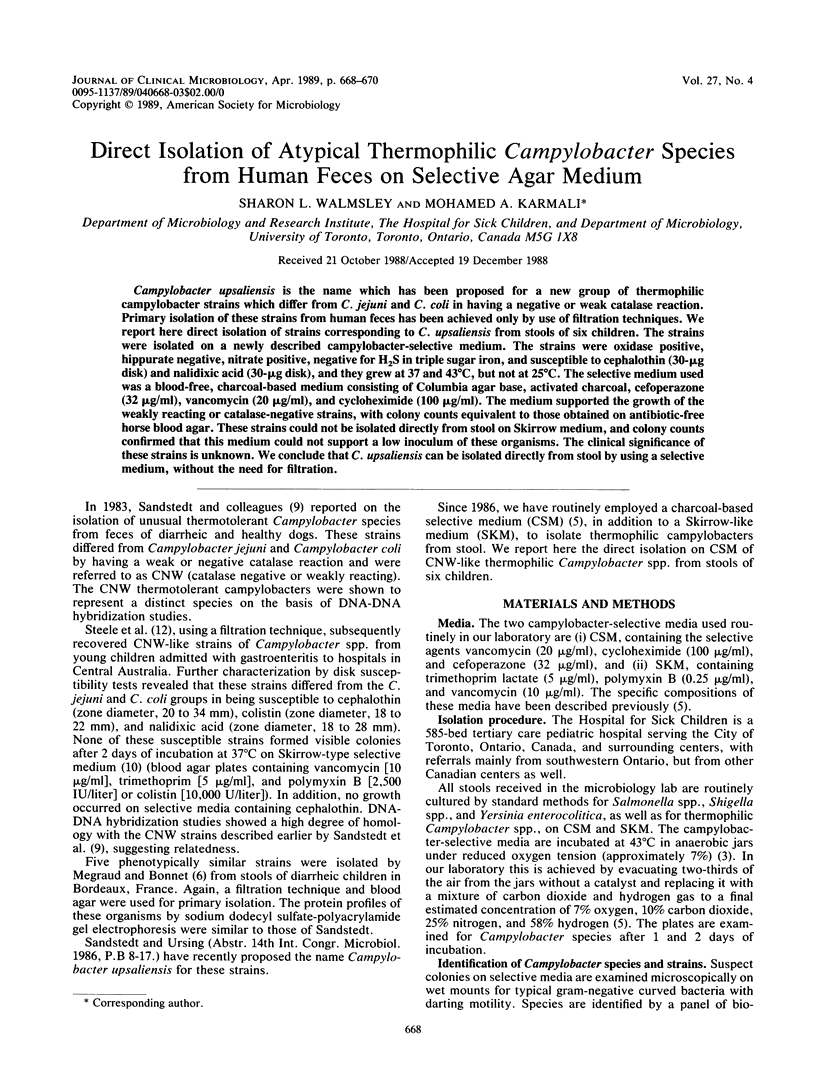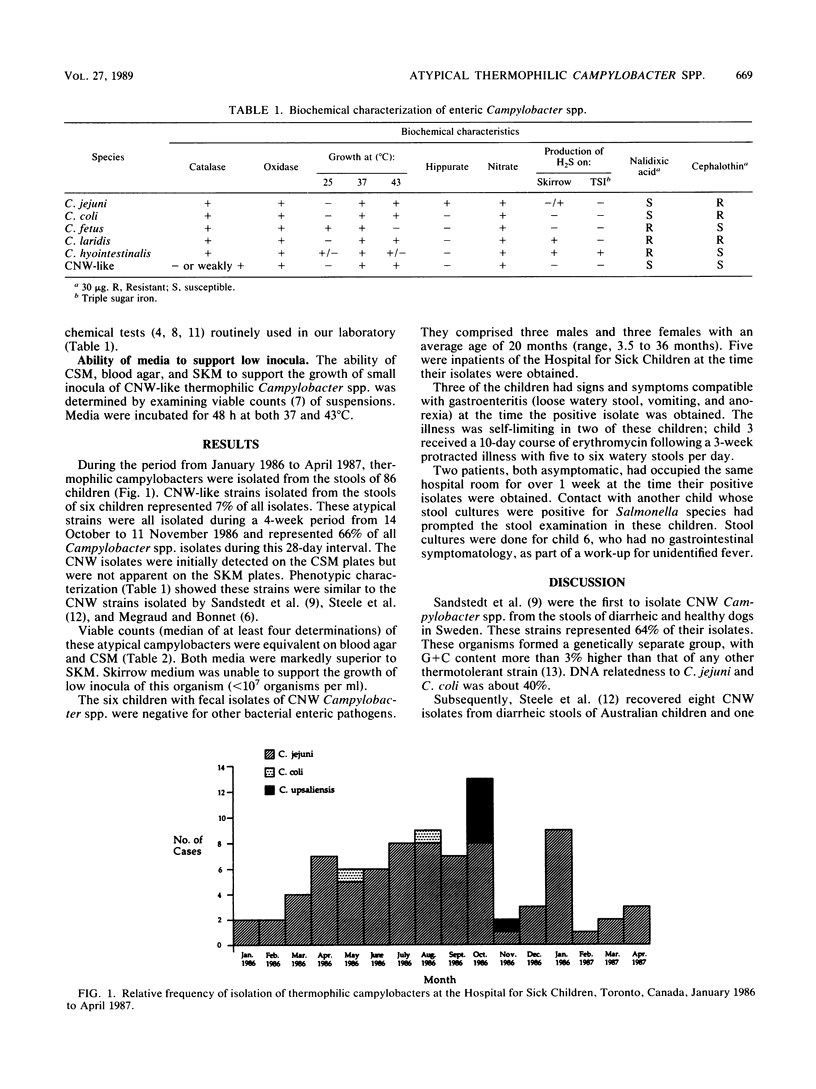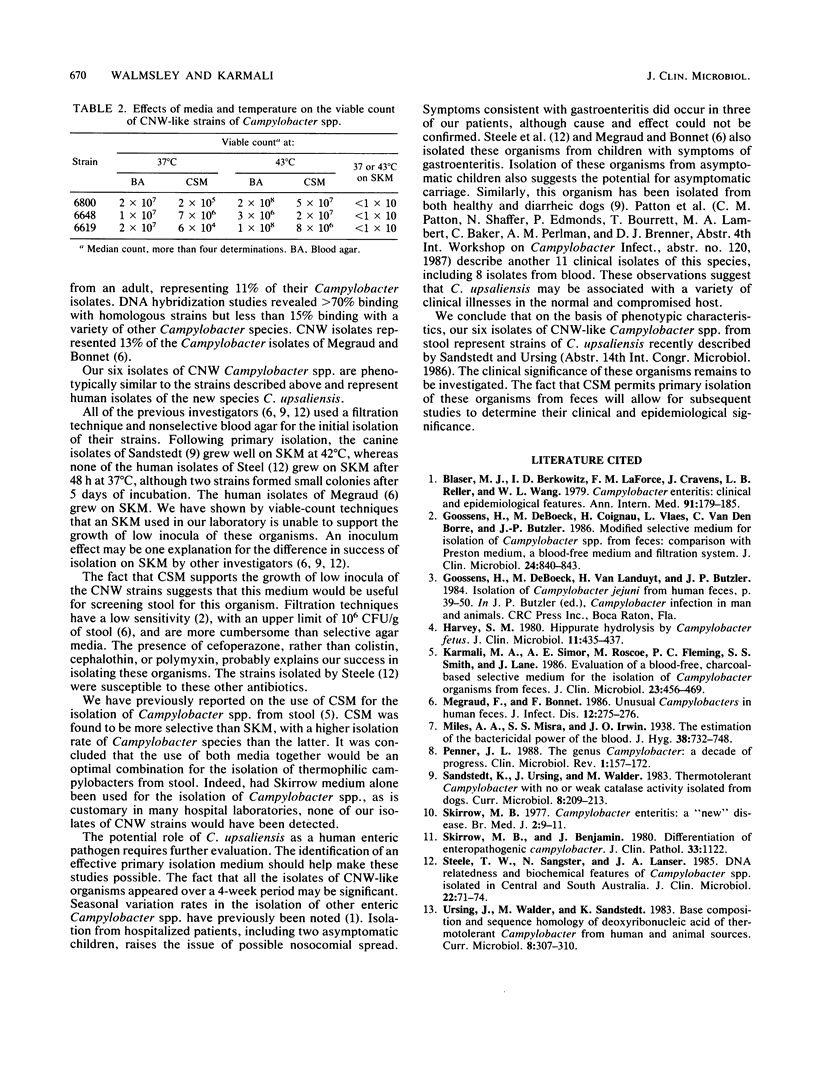Abstract
Campylobacter upsaliensis is the name which has been proposed for a new group of thermophilic campylobacter strains which differ from C. jejuni and C. coli in having a negative or weak catalase reaction. Primary isolation of these strains from human feces has been achieved only by use of filtration techniques. We report here direct isolation of strains corresponding to C. upsaliensis from stools of six children. The strains were isolated on a newly described campylobacter-selective medium. The strains were oxidase positive, hippurate negative, nitrate positive, negative for H2S in triple sugar iron, and susceptible to cephalothin (30-micrograms disk) and nalidixic acid (30-micrograms disk), and they grew at 37 and 43 degrees C, but not at 25 degrees C. The selective medium used was a blood-free, charcoal-based medium consisting of Columbia agar base, activated charcoal, cefoperazone (32 micrograms/ml), vancomycin (20 micrograms/ml), and cycloheximide (100 micrograms/ml). The medium supported the growth of the weakly reacting or catalase-negative strains, with colony counts equivalent to those obtained on antibiotic-free horse blood agar. These strains could not be isolated directly from stool on Skirrow medium, and colony counts confirmed that this medium could not support a low inoculum of these organisms. The clinical significance of these strains is unknown. We conclude that C. upsaliensis can be isolated directly from stool by using a selective medium, without the need for filtration.
Full text
PDF


Selected References
These references are in PubMed. This may not be the complete list of references from this article.
- Blaser M. J., Berkowitz I. D., LaForce F. M., Cravens J., Reller L. B., Wang W. L. Campylobacter enteritis: clinical and epidemiologic features. Ann Intern Med. 1979 Aug;91(2):179–185. doi: 10.7326/0003-4819-91-2-179. [DOI] [PubMed] [Google Scholar]
- Goossens H., De Boeck M., Coignau H., Vlaes L., Van den Borre C., Butzler J. P. Modified selective medium for isolation of Campylobacter spp. from feces: comparison with Preston medium, a blood-free medium, and a filtration system. J Clin Microbiol. 1986 Nov;24(5):840–843. doi: 10.1128/jcm.24.5.840-843.1986. [DOI] [PMC free article] [PubMed] [Google Scholar]
- Harvey S. M. Hippurate hydrolysis by Campylobacter fetus. J Clin Microbiol. 1980 Apr;11(4):435–437. doi: 10.1128/jcm.11.4.435-437.1980. [DOI] [PMC free article] [PubMed] [Google Scholar]
- Karmali M. A., Simor A. E., Roscoe M., Fleming P. C., Smith S. S., Lane J. Evaluation of a blood-free, charcoal-based, selective medium for the isolation of Campylobacter organisms from feces. J Clin Microbiol. 1986 Mar;23(3):456–459. doi: 10.1128/jcm.23.3.456-459.1986. [DOI] [PMC free article] [PubMed] [Google Scholar]
- Megraud F., Bonnet F. Unusual campylobacters in human faeces. J Infect. 1986 May;12(3):275–276. doi: 10.1016/s0163-4453(86)94398-7. [DOI] [PubMed] [Google Scholar]
- Penner J. L. The genus Campylobacter: a decade of progress. Clin Microbiol Rev. 1988 Apr;1(2):157–172. doi: 10.1128/cmr.1.2.157. [DOI] [PMC free article] [PubMed] [Google Scholar]
- Skirrow M. B., Benjamin J. Differentiation of enteropathogenic Campylobacter. J Clin Pathol. 1980 Nov;33(11):1122–1122. doi: 10.1136/jcp.33.11.1122. [DOI] [PMC free article] [PubMed] [Google Scholar]
- Skirrow M. B. Campylobacter enteritis: a "new" disease. Br Med J. 1977 Jul 2;2(6078):9–11. doi: 10.1136/bmj.2.6078.9. [DOI] [PMC free article] [PubMed] [Google Scholar]
- Steele T. W., Sangster N., Lanser J. A. DNA relatedness and biochemical features of Campylobacter spp. isolated in central and South Australia. J Clin Microbiol. 1985 Jul;22(1):71–74. doi: 10.1128/jcm.22.1.71-74.1985. [DOI] [PMC free article] [PubMed] [Google Scholar]


